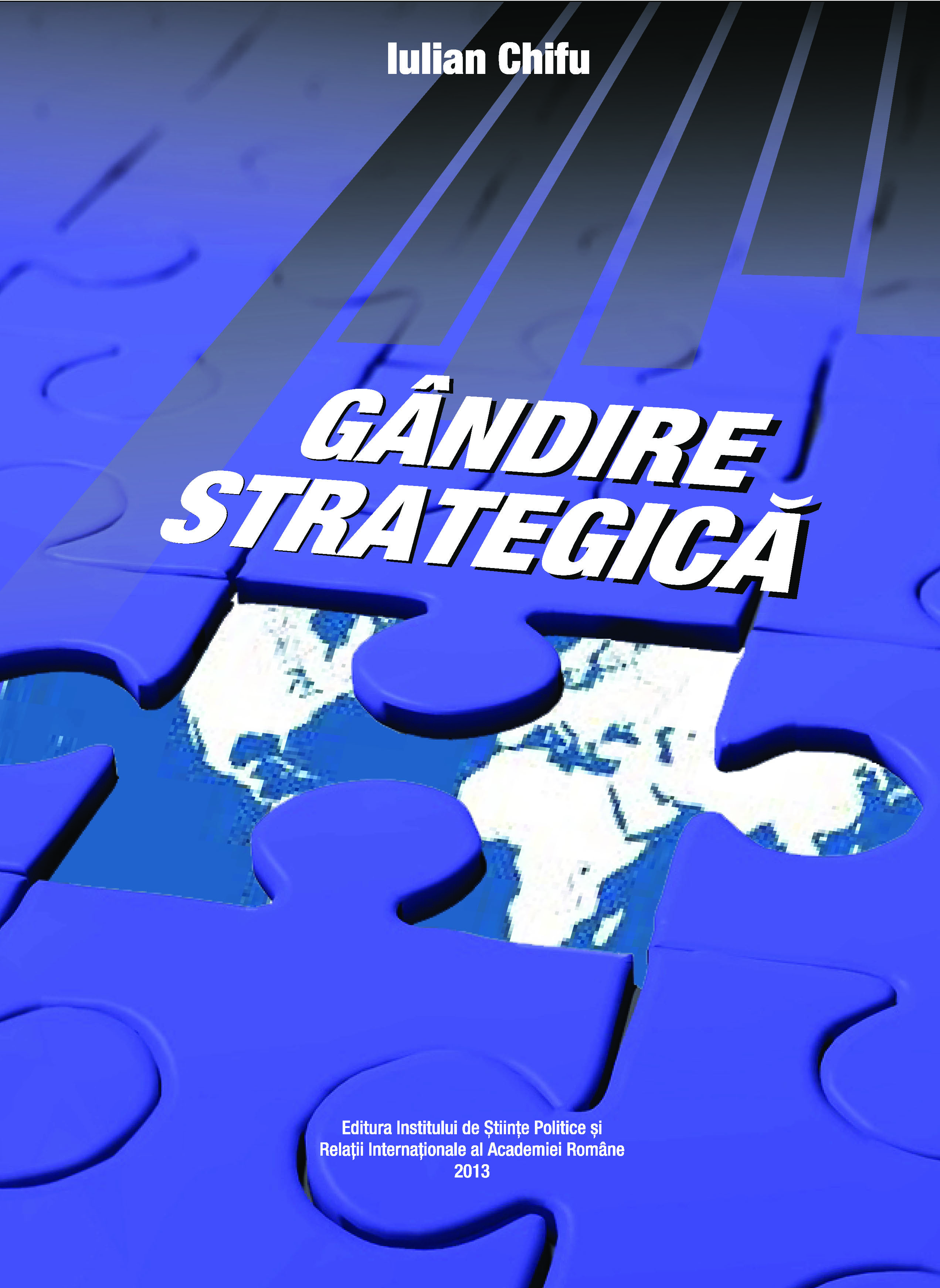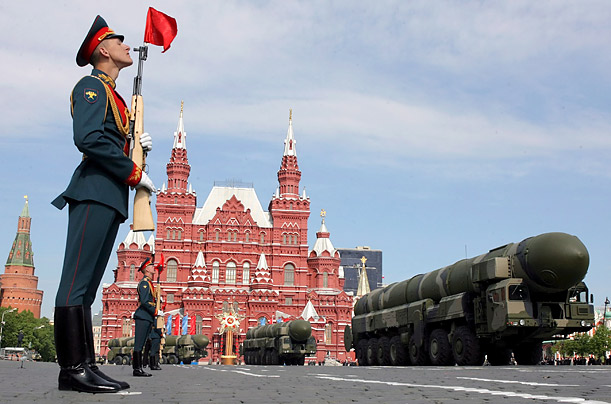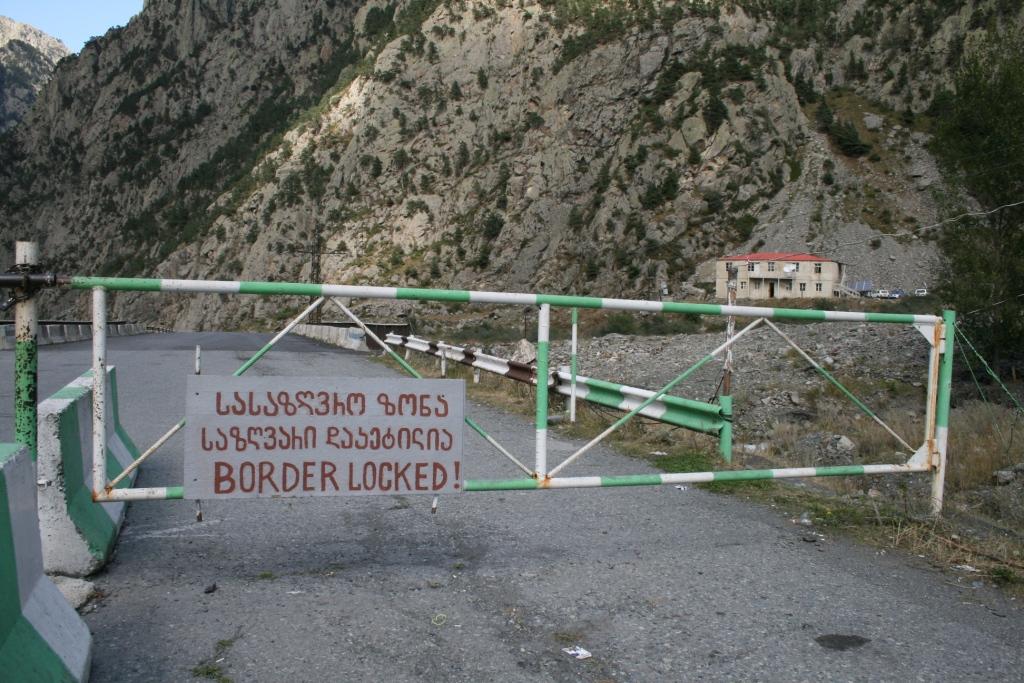The future shape of foreign affairs is a major concern for prospective studies as the very nature of international relations seems to be changing in accordance the post bipolar world. The transition is still ongoing, even though the final format is still undefined. In this context, the rules of the game are slightly changing from a pragmatic game of rivalries and control to a more strategic approach of positioning and filling the space for a possible use of those assets in a future confrontation. The name of the game is shifting from chess to Go.
read more
More
Cartea domnului Iulian Chifu intitulată „Gândire Strategică“ este o dovadă de mare temeritate din partea autorului. În primul rând pentru că într-o societate dominată de „mica politică“ abordarea unei asemena teme apare ca fiind insolită și nerelevantă pentru majoritatea actorilor politici. În al doilea rând, pentru că temele concrete pe care le abordează sunt, multe dintre ele, cum ar fi „coabitarea“, teme care fac obiectul unor dezbateri publice contradictorii. Toate acestea, în opinia mea, nu fac decât să sublinieze importanța lucrării care se constituie într-o adevărată pledoarie în favoarea unei idei, extrem de importante și de actuale, aceea a necesității unei viziuni românești asupra unei strategii naționale, transpartinică și pe termen lung, în domeniul politicii externe, a securității și apărării, pe care autorul o denumește „Mare strategie“. Argumentele sale referitoare la nevoia de a nu irosi resursele, mai exact de a valorifica la maximum resursele existente prin utilizarea integrată a tuturor instrumentelor la dispoziția unui Stat pot și trebuie să fie completate cu argumentul forte că în lipsa unei asemenea strategii politica externă a României riscă să fie lipsită „de busolă“ și să aibă un caracter de improvizație sau reacție la diferite evenimente care se petrec pe plan internațional așa cum s-a întâmplat după epuizarea obiectivului strategic al aderării țării noaste la sistemul instituțiilor euro-atlantice, în primul rând NATO și Uniunea Europeană.
Download pdf
More
by Bordei Ciprian
Russia’s large geographical size and remoteness from attacking powers; its strong control over resources and society exercised by its centralized state and its low level of dependence on the world economy, make Russia an autonomous player in world politics despite its relative backwardness. Russia’s political class perceives its country as a global power and the major regional power – and consequently as the main guarantor of security – in its immediate neighbourhood.
Russia is undoubtedly a European state if only geography as well as European civilization, its culture, tradition and religion are taken as the defining criteria. What places Russia beyond Europe’s bounds is its politics.
Read more….
More
BY Lavinia Lupu
Being located at the crossroads of the major Eurasian transport corridors, with huge resources and an important growth rate, Azerbaijan has now the opportunity of putting in practice his objective of becoming a regional hub between Europe and Asia. Having chosen the Western direction, Azerbaijan is involved in large-scale projects of European interest and the East-West Black Sea Caspian Sea Corridor must not be absent from Baku’s plans.
Choosing to be part from the East-West Strategic Corridor linking Central Asia to the Euro-Atlantic Area and implicitly, to collect the economic and strategic advantages that come along with it, Azerbaijan will strengthen its position in the Caucasus and its role of stabilizer in the region.
Key words: The East-West Strategic Corridor, The New Silk Road, Azerbaijan
Read more….
More
Bogdan Nedea
Georgia’s importance as a transit country and as a reliable ally for the West was undeniably proven once it became an important piece of Europe’s energy security as a transit country in two major pipelines: Baku-Tbilisi-Ceyhan (BTC) and Baku-Tbilisi-Erzurum(BTE). BTC affords western access to Caspian Sea and Central Asian energy, offering a choice of customers to the landlocked producing states. Parallel to BTC, natural gas flows from the Caspian Sea’s Shah Deniz field through the South Caucasus Pipeline to the Turkish city of Erzurum, bound for consumers throughout Europe. Moreover, the Baku-Supsa Pipeline and the Baku-Batumi railroad carry oil to tankers at Georgia’s Black Sea ports. Together, these energy conduits form the critical mass required to promote and sustain a broad East-West commercial corridor. Individual pipeline projects of the Southern Gas Corridor were already developed by the respective companies at the beginning of the 2000s, the Southern Gas Corridor, as an overarching concept, only emerged later. It was first described as a “project of European interest”, connecting the countries of the Caspian Sea and the Middle East by long-distant natural gas pipelines with the European Union, in a decision of the European Parliament and the Council of September 2006, coded as “NG3”. ..
Read more….
More
The absence of the strategic vision guiding the activities in intelligence gathering and analysis can lead to failures due to the short term and immediate operational or tactical solution envisaged in one issue or another. Without an integrative strategic vision, a Grand Strategy following long term goals and developing trans-partisan policies in Foreign policy, security and defense of one country, this could lead to blockages and failures that do not belong to bad evaluation but to the context and integrative force that a consistent strategy is offering.
The case of home grown terrorist is such a case. On one hand there is the need to intervene in difficult cases of the “enemy inside the gates” paradigm, on the other this type of intervention creates moral problems and is in a situation where, there is a possibility that this intervention could lead to the opposite outcome, meaning to qualify terrorists and to let them at large, instead of blocking the tendencies of some targeted lone wolf self radicalized Islamists moving towards terrorist action to make the move.
Read more….
More
Between the 20th and the 21st May in Chicago took place the NATO summit, in the presence of heads of states or governments of over 50 countries and international organizations. The summit took place in the framework of three official meetings with distinct formations – The North-Atlantic Council (28 member states with the participation of the President of the European Council Van Rompuy and of the European Commission, Jose Manuel Barroso), the ISAF format (with the main contributors and transit states for the retreat from theatre, with the participation of ISAF non-NATO contributors, Afghanistan, Japan, Kazakhstan, the Kyrgyz Republic, Russia, Tajikistan, Turkmenistan, the UN Secretary General, the President of the European Council, the President of the European Commission and the President of the World Bank) and the NATO and relevant partners formula. The latter was also in an ad hoc format, with the participation of heads of states or governments from Australia, Austria, Finland, Georgia, Japan, Jordan, Korean Republic, Morocco, New Zealand, Qatar, Sweden, Switzerland, and United Arab Emirates. Also, the ministers of foreign affairs and the ministers of defense had distinct meeting formats on specific topics. For instance, the NATO ministers of foreign affairs met their counterparts from the 4 partner nations aspiring to become full members of the Alliance – Bosnia and Herzegovina, Georgia, Macedonia and Montenegro.
Five documents have officially been published: the Chicago Summit Declaration, the Chicago Summit Declaration on Afghanistan, the Summit Declaration on Defense Capabilities, the Deterrence and Defense Posture Review and NATO’s Policy Guidelines on Counter-Terrorism.
Read more….
More
Abstract
The need for a Grand Strategy[1] of any country, which we’ve argued about[2], is just the first instrument that can create a framework for developing a national foreign policy. A consensus of the political class is needed in the name of a country’s national interest and for the linked foreign policy objectives. And that’s where the big lines and priorities appear, according to the concept that establishes those objectives at the level of the Strategy.
When planning, alternative possibilities to realize those objectives appear and it is up to the decision makers to choose one of the possible concrete options at a certain moment, according to the context and the current evolution. It is also up to the same political class to update the original version of the Strategy and to adapt it to the evolutions of the international system and of the policies of the actors involved globally or regionally[3].
The Strategic Partnership is one of the most important instruments for this purpose, even though there are different approaches to this concept and a random use of it. Romania has also made use of it in strategic projects as the transatlantic link, the North-South Euro-Atlantic Spine and the East-West Strategic Corridor to Central Asia[4]. Another major challenge is adapting the level of ambition to the resources, as well as reaching political consensus[5] for new objectives after the accession into EU and NATO.
Read more….
[1] John Lewis Gaddis, What is Grand Strategy, Yale University, Prima Telegramă a Consorţiului pentru Marea Strategie
[2] Iulian Chifu, Nevoia de a reveni la fundamentele marii politici: Marea Strategie a României, Infosfera, An IV, nr,2/2012.
[3] Louis J. Halle, The elements of International Strategy (Lanham, MD: University Press of America, 1984), p.15.
[4] Iulian Chifu, Strategia de Securitate, Politică Externă şi Apărare a României, Ocasional paper, 8 iulie 2009, www.cpc-ew.ro
[5] Iulian Chifu, România – actor strategic la frontiera UE şi NATO. Un proiect pentru România, ocasional paper, 15 iunie 2010, www.cpc-ew.ro
More
Lucrarea de faţă are ca scop analizarea atacurilor teroriste din Mumbai din perioada 26-28 noiembrie 2008. Acestea au reprezentat cele mai lungi atacuri desfăşurate vreodată de către un grup mic de terorişti (mai mult de 60 de ore) dar şi cel mai sângeros atac la care a asistat India. Acesta criză a presupus o serie de 5 atacuri teroriste ce au avut loc simultan în oraşul Mumbai din India. În cadrul acestuia au fost folosite aproape toate dispozitivele teroriste inclusiv incendierea, focurile de armă, bombardarea, luarea de ostatici şi atacurile cu grenade. Atacul a fost o reflecţie a planificării şi executării meticuloase bazate în principal pe crearea confuziei şi pe punerea în dificultate a autorităţilor prin tactici mixte, de aceea felul în care au gestionat autorităţile criza a atras critici atât pe plan intern cât şi pe plan internaţional. Mai mult decât atât, s-a sugerat faptul că aceste atacuri au prevestit apariţia unei noi organizaţii teroriste ce poate fi comparată cu Al Qaida, pe baza faptului că a avut capacitatea de a planifica şi execută atacuri teroriste cu o semnificaţie strategică importantă. Analiza crizei alese va fi făcută conform modelului cognitiv-instituţional sau al „modelului în patru paşi” şi se va baza exclusiv pe surse şi rapoarte publice ce nu pot fi verificate în totalitate.
Read more….
More
Scopul acestei lucrări este să analizeze decizia în criză în cazul incendiului de la Spitalul Clinic de Obstetrică Ginecologie „Prof. Dr. Panait Sârbu” în data de 16 august 2010 din Bucureşti, în urma căruia au decedat 6 nou născuţi, iar alţi 5 au suferit vătămări corporale grave. Întregul eveniment a declanşat o criză puternică care a pus la grea încercare autorităţile competente şi a avut un impact deosebit de mare în întreaga ţară. Felul în care a fost gestionată criza şi cauza declanşării incendiului a ridicat numeroase întrebări.
Menţionăm că nu ne propunem să realizăm o anchetă a acestui caz. Chestiunile legate de stabilirea vinovăţiei, aspectele legate de ordin penal şi procesual penal nu fac obiectul acestei analize. Putem preciza însă că acest caz a fost preluat de Secţia de Urmărire Penală şi Criminalistică a Parchetului de pe lângă Înalta Curte de Casaţie şi Justiţie, procurorii începând urmărirea penală in rem pentru ucidere din culpă şi vătămare corporală gravă. Ceea ce ne propunem să analizăm este decizia în criză.
Modelul pe care l-am ales în vederea analizei deciziei în criză este cel cognitiv-instituţional „în patru paşi”, aplicabil pentru toate crizele, indiferent de domeniul în care se produc, de perioadă sau decident. Acest model este folosit în programul european de management al crizelor CRISMART[1]şi de ECMA – European Crisis Management Academy. Metodologia constă în descompunerea procesului de luare a deciziei din momentul crizei încercând să redăm percepţia principală asupra crizei, să încadrăm problema, modul în care această problemă este definită de către factorii de deciziei, planul de rezolvare a problemei şi în ce măsură acesta a avut succes
[1] CRISMART – Crisis Management Research and Training – un program al Swedish National Defense College – SNDC, Stokholm.
Read more …
More










